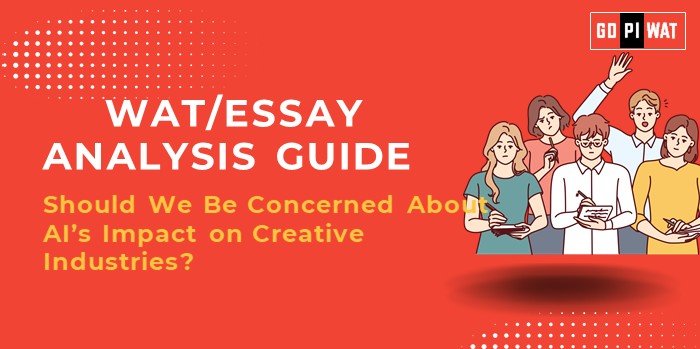📋 Written Ability Test (WAT)/Essay Analysis Guide: Should We Be Concerned About AI’s Impact on Creative Industries?
🌐 Understanding the Topic’s Importance
AI’s foray into creative industries raises debates about balancing efficiency and innovation with originality and ethics, offering a nuanced issue for management discussions.
📝 Effective Planning and Writing
- ⏱️ Time Allocation:
- Planning: 5 minutes.
- Writing: 20 minutes.
- Review: 5 minutes.
- 📌 Preparation Tips: Note 2-3 critical challenges and solutions; cite relevant statistics.
📖 Introduction Techniques for Essays
🎭 Contrast Approach:
“AI-generated art can win competitions, but it struggles to evoke human emotion, presenting a paradox in creativity.”
🔧 Solution-Based:
“AI tools, while efficient, need ethical guidelines to safeguard human creativity.”
📜 Historical Context:
“From Gutenberg’s press to AI tools, technology has always redefined creativity.”
📚 Structuring the Essay Body
🏆 Achievements:
- AI democratizes creativity, allowing broader access to tools for art, music, and writing.
- Enhances efficiency by automating repetitive tasks, enabling creators to focus on innovation.
⚠️ Challenges with Comparative Analysis:
- Ethical dilemmas in originality and ownership of AI-generated content.
- Global benchmarks: Estonia’s transparent AI policies vs. China’s rapid yet controversial adoption of AI in creative industries.
🔮 Future Outlook:
- Collaborative models where AI enhances but does not replace human creativity.
- Integration of ethical frameworks to ensure fairness and sustainability in creative professions.
📌 Concluding Effectively
⚖️ Balanced Perspective:
“AI in creative industries reflects both progress and caution. Its true potential lies in collaboration, not competition.”
🌍 Global Examples:
“As seen in Estonia and China, balanced adoption of AI can preserve artistry while embracing efficiency.”
🔍 Analyzing Successes and Shortcomings
- ✅ Achievements: Accessibility, speed, and novel creative possibilities.
- ❌ Challenges: Job displacement, bias, and legal loopholes in AI-generated content ownership.
- 🌍 Global Context: Estonia’s balanced policies vs. China’s rapid but ethically controversial adoption.
💡 Recommendations for Sustainable Progress
- Develop transparent AI policies focusing on originality and fairness.
- Incentivize hybrid AI-human creative projects to enhance collaboration.
- Foster global collaboration to address copyright and ownership issues.
📄 Sample Short Essays
⚖️ Balanced Perspective:
“While AI revolutionizes art and media, human creativity’s irreplaceable emotional depth ensures a future of coexistence.”
🔧 Solution-Oriented:
“Clear policies on AI originality and fair usage will protect jobs and maintain ethical integrity.”
🌍 Global Comparison:
“Estonia’s policies exemplify a balanced AI adoption model, ensuring creative industry sustainability.”


